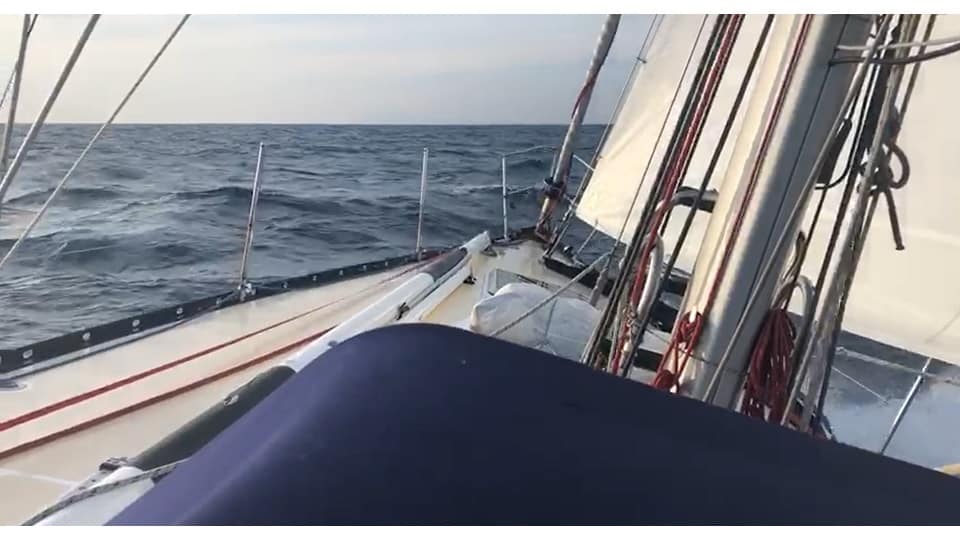October 29 - Flat sea, little wind. We sail near Porquerolles, the largest of the islands of the Hyerès archipelago.
In 1971, the French State bought 80% of the island to convert it into a comprehensive protection park, the current national park of Port-Cros.
On board the Bamboo the atmosphere is calm, even the only "earthling" of the crew, who had to fight seasickness on the first day, has now adapted.
Porquerolles beauty fills the heart. And it is a beauty that surrounds, calms, enchants.
“Look… a submarine!” The signal comes suddenly. It has the effect of a sudden awakening from a beautiful dream.
But how? We were sailing in a sea of beauty and suddenly there is a black silhouette that runs straight east-southeast.
A menacing silhouette, with its turret emerging from the waves.
We grab our mobile phones to take some pictures and then display the March flag with the absurd pretense of trying to make a shot with the turret in the background.
An image that says: we are here and we do not want this in the Mediterranean. The intention is good but the submarine sails very fast and in a moment we have it aft. Too far.
We are near Toulon, the base of the French nuclear submarines
“We are close to Toulon, the base of the French nuclear submarines. Who knows where this one is going?” Alexander wonders, as the dark silhouette disappears behind us.
In Toulon, in fact, is the largest base of the French navy that houses the nuclear attack submarines, the SNA. The first was delivered in 1983, then in ten years five more arrived.
Currently, of the six nuclear submarines, two are stationary for repairs and two are dedicated to the protection of nuclear deterrence.
Two others are engaged in conventional missions, including the protection of the air and sea group.

To compensate for the aging of the naval nuclear arsenal, France launched last July Suffren, the first of the six new nuclear attack submarines of the Barracuda class. It was built by the colossus Naval Group, which signed an important operation with the Italian Fincantieri.
At nightfall, we comment on this information among ourselves and do not get carried away for a moment by discouragement thinking about international nuclear disarmament treaties.
The foreign ministries of the world are full of good intentions that were left on wet paper.
In 1995, the Mediterranean states signed the Barcelona Declaration
In 1995, the Mediterranean states signed the Barcelona Declaration, which was supposed to be the founding act of a global partnership between the European Union (EU) and twelve countries in the southern Mediterranean.
The purpose of the association is to make the Mediterranean a common area of peace, stability and prosperity, by strengthening dialogue
political and security, economic and financial cooperation and social and cultural relations.
The goals include: "promote regional security, eliminate weapons of mass destruction, adhere to international and regional nuclear non-proliferation regimes, as well as disarmament and arms control agreements."
We have on board two young people who had not yet been born in 1995, other sailors who were already more than adults that year.
In summary, the statement has been transmitted in vain for at least two generations. Thinking about it, arms fall. And it is not over.
The first international treaty for the prohibition of nuclear weapons was signed at 2017
The first binding international treaty for the prohibition of nuclear weapons was signed worldwide at 2017.
Signed by 79 countries has a clause (Article 15) that makes it an anchor: the treaty will only enter into force when it is ratified by 50 States.
At present, only 33 States have ratified it. Italy is not among them. France, much less.
"Compared to other treaties, 33 ratifications have already come in just two years," says Alessandro.
Yes, but missing 17 signatures for the entry into force of the TPAN.
The mistral has arrived, night navigation to Marseille promises to be difficult
Meanwhile, the wind grows and the sea is agitated. The mistral has arrived, night navigation to Marseille promises to be difficult. The captain organizes watch shifts.
Unlike international treaties on nuclear disarmament, surveillance shifts take effect immediately and are operational from the moment they are drawn up.
While the first shift is getting ready, a noise is heard in the bow: at night a dolphin jumps out of the water and swims for a few minutes by the ship.
Expressions of amazement, joy and joy begin. The dolphin, the protector of the crew according to legend, is always an amazing encounter. No matter how many you have seen: each time is like the first.
It is dark. The Bamboo advances decisively through the waves with its small navigation lights.
We, the crew, have two images left: the submarine and the dolphin. Two images of the Mediterranean, one speaks of death, the other of life.


2 comments on “Logbook, October 29”